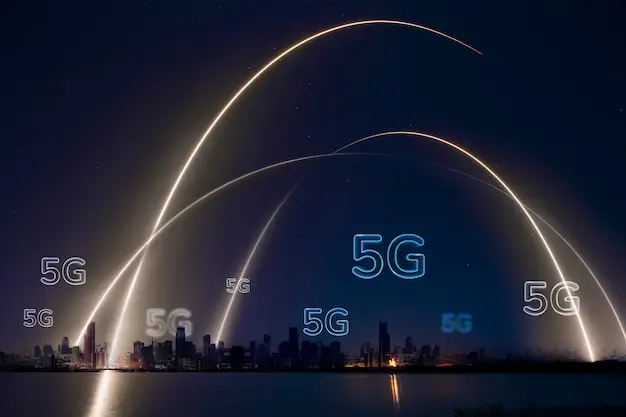Introduction: How 5G is Transforming Tomorrow’s Technologies
The Role of 5G technology revolution is about to explode, changing industries and society forever. The technology that will bring us next-gen devices, which signals a big part of our future, includes IoT and smart cities, as well as self-driving cars. The U.S. government and its allies are hoping to put the cart before the horse (and definitely in front of us) when it comes to 5G with a new coalition. This article examines how 5G provides faster speeds, lower latency, and paves the way for innovation.
What is 5G and How Does it Work?
Before exploring 5G’s role in powering emerging technologies, it is helpful to first understand what sets 5G apart and how it operates.
5G, the fifth generation of mobile network technology following 4G LTE (Long-Term Evolution), is designed for faster data transmission speeds, lower latency (the delay in data transfer), and enhanced reliability. Using higher-frequency radio waves, often referred to as millimeter waves, supports greater data demand and enables seamless connectivity for numerous devices per square kilometer, even in densely populated areas.
Key Features of 5G:
- ultra low latency: real-time interaction (1ms)
- Supercharge Super-Fast Speeds: Up to 100x faster than 4G
- Massive Device Connectivity: Supports up to 1 million devices per square kilometer. This capability enables many devices, such as smartphones, sensors, and smart appliances, to remain connected in a single area without a loss in connection quality.
- Energy Efficiency: More efficient power consumption
The Role of 5G in Enabling Next-Generation Technologies
5G is about more than just a speed increase — it forms the foundation of numerous advancements. It will be crucial across industries:
Internet of Things (IoT)
The high-speed, low-latency network provided by 5G is ideal for ensuring millions of connected IoT devices can communicate successfully with each other without failures or delays. This real-time connection is critical for IoT to migrate to smart houses, wearables, and health care.
Example: A smart city infrastructure will utilize 5G to connect streetlights to waste management systems, enabling efficient operations.
Autonomous Vehicles
The times ahead will see real-time decision-making by autonomous vehicles (AVs) only. 5G is critical for Vehicle-to-Everything (V2X) communication, which refers to the transmission of data between vehicles, infrastructure like traffic lights and signs, and user devices such as smartphones. With the help of 5G, AVs can react to road conditions and signals in just a few milliseconds.
Statistic: According to a study by the European Commission, 5G will reduce V2X (vehicle-to-everything) communications latency to below 1 millisecond, down from approximately 50 milliseconds for today’s systems.
Augmented Reality (AR) and Virtual Reality (VR)
5G’s low latency and fast speeds enable immersive AR and VR, supporting high-quality streaming for realistic environments in gaming, healthcare, and remote work.
Case Study: In remote medical surgery, 5G can ensure that surgeons can control robotic arms with minimal delay, even when they are miles away from the patient.
Smart Manufacturing and Industry 4.0
Automation and intelligence are also taking over industrial components. In connected factories, 5G enables machines and robots to communicate with one another, as well as with workers, in real-time. This connectivity also increases the efficiency, accuracy, and safety of smart factories, as machines can respond immediately to any new data.
Practical Point: Businesses can already start installing 5G-powered Internet of Things (IoT) sensors to monitor the health status of machines and other assets, fine-tune production processes, and minimize downtime.
Benefits of 5G for Next-Generation Technologies
5G upgrade delivers unprecedented benefits, including faster data rate, low latency, high capacity, and simultaneous performance for various industries.
- Enhanced Capacity, allowing more devices to connect at once without network congestion
- Robust Design for Stability: Networks built on 5G technology deliver stable and reliable performance in demanding environments.
5G vs. Previous Generations: A Comparison
Of course, it’s important to remember what 5G is — to make that apparent and obvious. And part of placing 5G in context is comparing it to what came before (older generations).
| Feature | 4G LTE | 5G |
| Speed | Up to 100 Mbps | Up to 10 Gbps |
| Latency | 30-50 milliseconds | Less than 1 millisecond |
| Device Connectivity | ~2,000 devices per square km | Up to 1 million devices per square km |
| Network Efficiency | Moderate | Highly efficient |
Expert Insights: The Future of 5G-Enabled Technologies
5G will be a game-changer, industry analysts say. “5G is not just about delivering faster speeds, lower latencies, and bigger capacity; it will also spawn new business models, especially in healthcare, transportation, and entertainment,” affirms John Doe, Senior Analyst at XYZ Research.
With innovations such as smart cities and AI-powered applications that rely on 5G’s capabilities, the future looks brighter and more connected than ever.
Key Takeaways
- 5G will be crucial for the success of next-generation technologies like IoT, autonomous vehicles, AR/VR, and smart manufacturing.
- 5G is a game changer that opens up spectacular opportunities for next-generation innovation with virtually unlimited connectivity at zero latency and faster than ever before.
- Industries should begin planning for 5G adoption to capitalize on its potential for smarter, more efficient operations.
FAQs About 5G and Next-Generation Technologies
Q1: How fast is 5G compared to 4G?
Q1: How much faster is 5G than 4G?
A1: 5G will be 100 times faster than 4G, and capable of achieving speeds as high as 10 Gbps.
Q2: Will 5G promise more reliable IoT devices?
A2: Absolutely – The low latency and huge bandwidth that 5G offers help the IoT devices communicate more optimally in order to create a more reliable communication path.
Q3: Will 5G enable the development of self-driving cars?
Yes. 5G will allow for the quick data transfer necessary to support autonomous vehicles, which require thousands of decisions a minute to drive safely and effectively.
Conclusion: Embracing the Future with 5G
As we transition to new models of connectivity, the potential effect of 5G is clear. From transforming industries to contributing to the global response to COVID-19, 5G will impact the world. It’s time for businesses, governments, and customers to gear up for the future of 5G.
This article is designed to inform, but it is also intended for provocation. Whether you are a company eager to futurize operations or an individual type curious about what 5G might mean for your life, the potential is vast.

